Preparation of Marketable Functional Food to Control Hypertension using Basil (ocimum basillium) and Peppermint (mentha piperita).
Afshan Saleem1, Arjumand Iqbal Durrani1, Fatima Batool Awan2, Amina Irfan2, Misbah Noreen2, M Ali Kamran3 and Duaa Arif2.
1 Department of Chemistry, University of Engineering & Technology Lahore.
2Department of Zoology, University of the Punjab Quaid-e-Azam Campus Lahore.
3 Department of Physics, University of the Punjab Quaid-e-Azam Campus Lahore.
*Correspondence | Afshan Saleem E.Mail. afshan.jutt66@yahoo.com Department of Chemistry, University of Engineering & Technology Lahore.
Citation | Saleem A, Durrani A.I, Fatima B.A, Irfan A, Noreen M, Kamran A and Duaa A Preparation of Marketable Functional Food to Control Hypertension using Basil (ocimum basillium) and Peppermint (mentha piperita). International Journal of Innovations in Science and Technology, Vol 01 Issue 01: pp 15-32, 2019.
DOI | https://doi.org/10.33411/IJIST/2019010102
Received | Dec 24, 2018; Revised |Jan 22, 2019 Accepted | Jan 25, 2019; Published | Jan 28, 2019.___________________________________________________________________
Abstract.
Functional foods are of great importance which are used to ensure improvements in human health by all aspects. A potential functional food was prepared with five different formulations A, B, C, D and E by using different combination of basil leaf, peppermint leaf and green cardamom to control hypertension. The raw material used for formulation wAS collected from the local market of Shahdara Lahore in September 2017. Selection of raw materials was totally based on the availability of specified bioactive components which can control hypertension. Formulations A, B, C, D and E were sensory evaluated. The overall acceptability for formulation A was 5/10, B was 6/10, C was 8/10, D was 9/10 and E was 7/10. On the basis of sensory analysis, formulation D was selected. For preliminary analysis, ethanolic and ethyl acetate fraction of basil leaf was prepared. Standard methods of phytochemical analysis were performed to identify flavonoids, alkaloids, polyphenolics and antioxidant activity. Antioxidant activity was measured by using DPPH assay. Quercetin was used as standard. Results were statistically analyzed which showed that IC50 (μg/mL) value of ethyl acetate fraction (389.00±0.99) was higher than the ethanolic extract (1372.00±6.32) of the basil leaf. On the basis of phytochemical analysis and DPPH assay. We formulated herbal tea that showed promising antioxidant properties. Characterization of food product proved it as potentially beneficial dietary supplement and hence recommended as potential functional food for hypertension.
Keywords: Hypertension; Functional food; DPPH; Sensory Evaluation and Antioxidant activity.
1. Introduction.
Hypertension or High Blood Pressure (HBP) has become a commonest disease specially in low- and middle-income countries [1]. About 9.4 million deaths occurred due to HBP in the year 2013 [2]. Number of adults suffering from HBP reached up to 13 billion in 2015 around the world. A number of factors are responsible for prevalence of HBP which include excessive intake of sodium products and alcoholic drinks and removal of vegetables and fruits from regular diet. This non-communicable disease can be developed by deficiency of various vitamins such as vitamins C, D, riboflavin and folic acid [3]. Many health organizations emphasized to reduce hypertension through dietary approaches [4]. A healthful life style is the key mechanism to reduce blood pressure. Molarity and cardiovascular diseases are mainly rooted by hypertension. It is proved through many researches that a sodium free diet along with excessive use of fruits may be beneficial against the attacks of hypertension [5, 6, 7]. The main components of healthful diet are fresh fruits, vegetables, grains, nuts, legumes and seafoods. However, the use of red meat and other sodium rich foods are highly restricted in HBP [8, 9, 10].
Functional foods are of great importance which are used to ensure improvement in human health by all aspects [11]. Functional foods are also known as food ingredients which can assist extraordinary in maintaining human health. These are the substances which take a part in growth and development of human bone structure [12]. According to American Dietetic Association (ADA), the functional foods are enriched foods designed to consume regularly for desired health issues. In 2012, the functional foods were defined in an international conference at Santa Barbara that these are natural or processed foods that contain known and unknown biologically active components in a defined amount which provides a clinically proven and documented health benefits for prevention, management and treatment of chronic diseases [13]. A big variety of functional foods is shown in the Figure 1 as below,

Figure 1. A brief description of functional foods. Modified after Cheryl Tay 2017, https://www.nutraingredients-asia.com/Article/2017/09/07/Vitafoods-Asia-2017.
Various foods can be used regularly to maintain the health properly which includes, ginger, garlic, celery and green tea. Garlic is considered as nice addition in regular diet to increase immunity and physical strength to reduce fatigue. Garlic is used in treatment and prevention of various infectious diseases. Cholesterol, blood pressure and cardiovascular health can be maintained by regular use of garlic [14]. Ginger is commonly known as Zingiber Officinale (ZO) that contains anions and
cations with a penalty of magnesium, calcium and phosphorus that functions to improve bone strength and nerve transmission. Ginger is considered best in various health issues like depression, nausea, confusion, weakness, convulsions and gastriointestive disorder [15]. Moreover, ginger is the main source which regulates heartbeats at regular order [16]. These all foods are considered good to be in taken by patients of hypertension.
Generally, hypertension has no symptoms until serious complications develop that’s why it is called "silent killer". There are 2 types of hypertension 1) when the condition has no known cause, it is called Primary Hypertension and this type of hypertension can be controlled but cannot be diagnosed [17, 18]. The diseases which are attributable to hypertension are shown in following Figure 2.

Figure 2. Various factors attributable to hypertension.
The hypertension due to some other indirect diseases/sources is known as Secondary hypertension. Nearly 10-12% of patients are the victim of secondary hypertension, where drug or comorbid are responsible for elevating blood pressure [19]. Hypertension has a variety of causes but in most of these cases, the most common is the deterioration, resulting from serious kidney disease or renovascular disease. Symptoms can differ between individuals depending upon the medical history etc. [20]
The hypertension due to increased peripheral resistance in arterial blood pressure is dangerous for health. It is further divided into 2 types: a) Beginning hypertension b) Malignant hypertension. The elevation in systolic blood pressure and diastolic pressure is about 200 mmHg and 100 mm Hg respectively. Systolic blood pressure is of 250 mmHg and the diastolic blood pressure is of 150 mmHg. It causes serious problems like retinal and renal diseases. Hypertension is a silent killer so death can cause immediately. [21, 22, 23]. Blood pressure is dependent upon the nature of blood vessels and the distance travelled. Vessels, closer to heart, experience more blood pressure. If the walls of arteries are thicker and less flexible while the vein’s walls are thinner and more flexible, this situation leads to low blood pressure [21, 22, 23]. Common determinants of hyper tension are follows, 1) weight is directly related to BP, higher the weight, higher will be the BP, 2) In both male and female, BP generally rises with the age 3). Addiction of Alcohol consumption causes in increase in 4) Burning of tobacco produces nicotine and carbon monoxide that causes hypertension and 5) the survey has been proved that hypertension may be caused by genetic problems. Normal and pulmonary hearts are shown in the Figure 3.
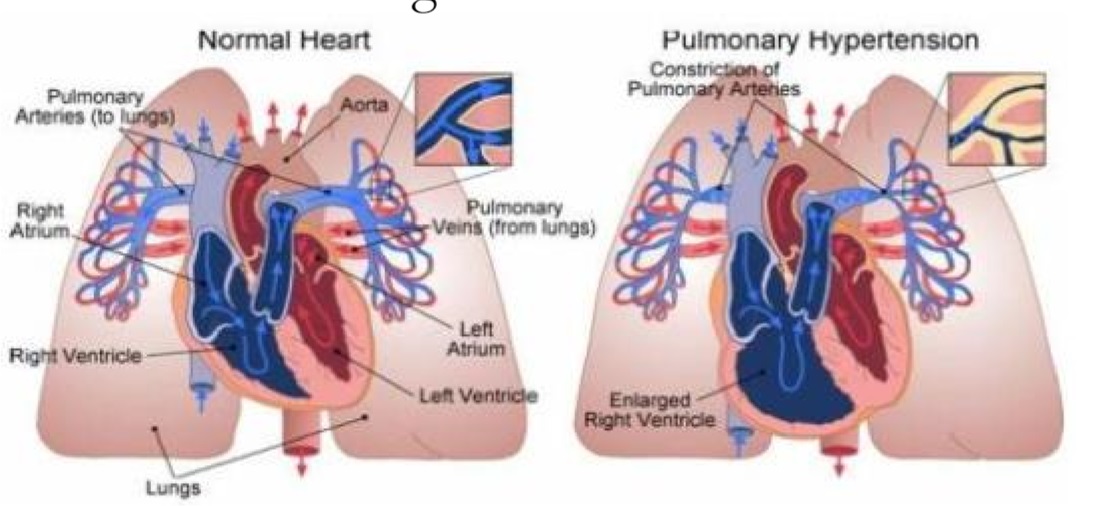
Figure 3. Normal and pulmonary hearts.
The “King of herbs” commonly known as Basil (Ocimum basilicum L.) is used in this research for curing hypertension shown in Figure 4. Linalool, eucalyptol, eugenol and chavicol are the essential oils of Ocimum basilicum, commonly known as basil. These oils are used as antioxidants. Eugenol is a type of phenolic component which have a large number of plant sources. Synthesized Eugenol has same properties as that of natural contains. Extracts of numerous medicinal herbs contain significant amount of eugenol that fascinated the attention of several researcher as it can be used as an alternative of medicine to prevent many disorders. World Health Organization (WHO) announced Eugenol as GRAS (Generally Recognized as Safe). Peppermint is used as food additive to enhance the taste as well as antioxidant activity of herbal tea. Cardamom is used for aroma [24, 25, 26].
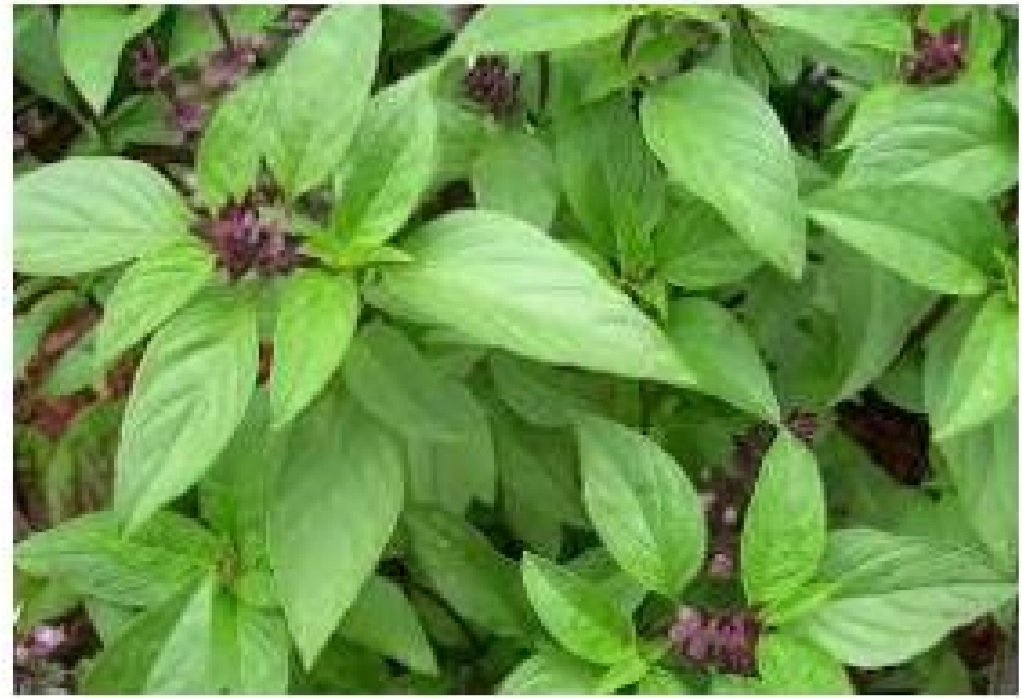
Figure 4. Basal leaves.
In many cultures and cuisines, basil is an important herb also known as Tulsi which is a spiritual herb in the Hindu religion and considered as holy. British used tulsi as a replacement of Bible. Bible is holy book of Hindus which is used in a court of law to take an oath [27].
Mentha piperita (Lamiaceae family) which is a common herb that is grown in Europe and North America shown in Figure 5.

Figure 5: Peppermint Leaves
Scientific name of Peppermint is Mentha piperita. Peppermint/Black mint is the common names of Peppermint which belongs to Lamiaceae family [28]. Peppermint contains different bioactive compounds like Menthol, Menthone, Isomenthone, Menthofuran, Neomenthol, Limonene, Cineole, and Pulegone etc. as shown in the figure 6.
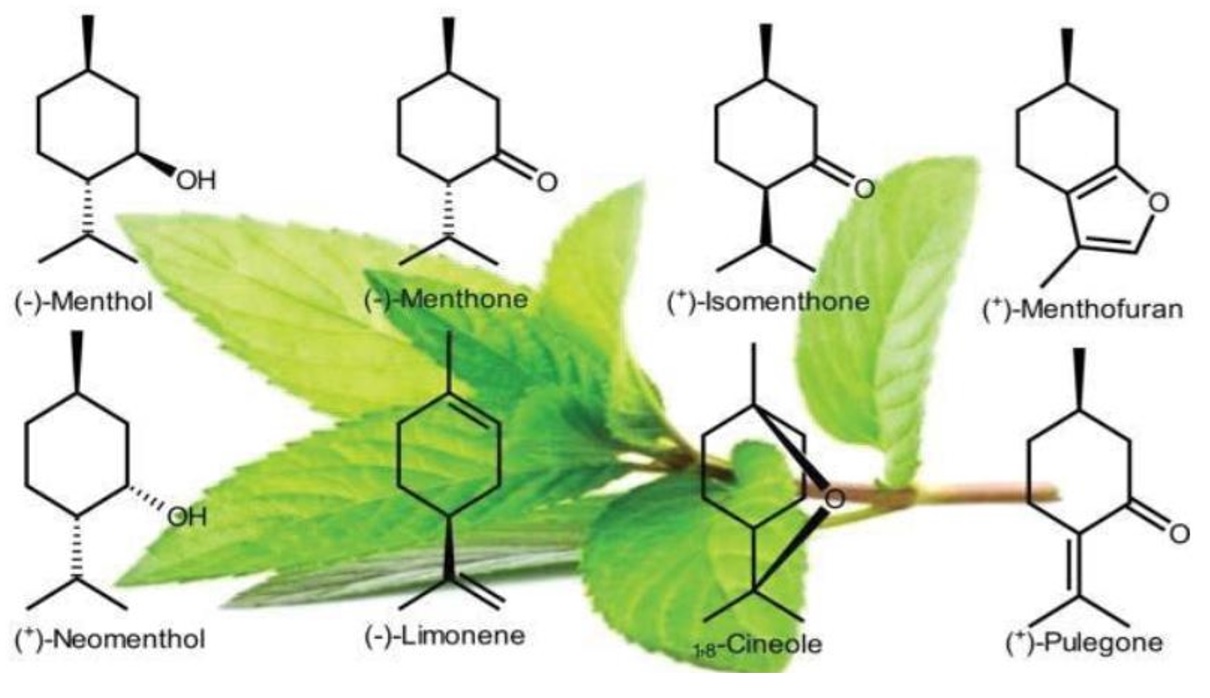
Figure 6: Bioactive compounds of Peppermint
Peppermint has a lot of health benefits as shown in following Figure 7. It is used as antioxidant, antiviral, antimicrobial, antispasmodic, antinociceptive, antitumorigenic, anticarcinogenic and allergic. [29]

Figure 7: Properties of Peppermint
The main objectives of this research were to prepare a potential functional food to control hypertension.
2. Material and methods.
Sensory evaluation is used in this research which is a specific discipline designed to touch, sight, taste, smell and hear the responses of various food products to analyze similarities and dissimilarities. This technique is defined to determine the gauge of acceptability of a product by all aspects [21]. After sensory evaluation herbal tea was characterized. For Preliminary extraction, ethanolic and ethyl acetate fraction was prepared to identify flavonoids, Polyphenolics, Alkaloids and antioxidant activity. For alkaloids identification, Dragendorff’s test, Hager’s test, Wagner’s test and Mayer’s tests were used. FeCl3 was used for the identification of Polyphenolics and DPPH (2, 2-Diphenyl-1-Picryl-hydrazyl) was used to check antioxidant activity [30].
2.1 DPPH Compound.
Diphenyl-1-Pircryl-hydrazyl is abbreviated as DPPH which is comprised of a stable free radical molecule that are crystalline in nature. These free radicals are atom, ions or molecules which form a dark matter. Free radicals cause oxidation of reduced molecules in cellular structures that includes ischemia, arthritis, atherosclerosis, cancer, gastritis and injury of central nervous system. These radicals can be effectively eliminated with the help of synthetic and natural anti oxidents by their decomposition [31, 32]. DPPH structure is drawn in Figure 8,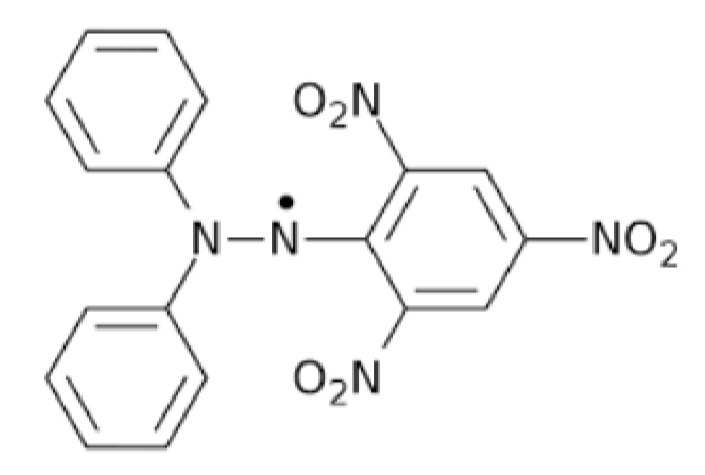
Figure 8. DPPH structure.
UV/VIS Spectrometer.
The ultraviolet and visible portion of electromagnetic spectrum are used in excitation of electrons from ground state to higher energy level. It consists of a light source, monochromator, sample compartment and the detector. The basic structure of UV/VIS spectrometer is drawn in the Figure 9.

Figure 9. Basic structure of UV/VIS spectrometer.
UV/VIS has large scale use in various analysis e.g., qualitative analysis, dissociation of acids and bases, quantities analysis, pharmaceutical analysis, chemical kinetics and weight determination at microlevels.
Chemicals used in this research.
All the chemicals used in this research work were of analytical grade.
Petroleum Ether: M. mass 82.2 g/mol, colorless, volatile, insoluble in water, soluble in organic solvents, specific gravity 0.64, CAS No. 8032-32-4, Trace SELECT Ultra grade by Sigma-Aldrich.
70% Ethanol (C2H5OH): M. mass 46.08 g/mol, colorless, volatile, specific gravity 0.8854, CAS No. 64-17-5, Trace SELECT Ultra grade by Sigma- Aldrich
Ethyl Acetate (CH3COOC2H5): M. mass 88 g/mol, specific gravity 0.895, colorless, soluble in alcohol and acetone, CAS No. 141-78-6, Trace select Ultra grade by Sigma- Aldrich
Ammonia gas (NH3): colorless, nonflammable and liquefied gas with strong smell, M. mass 17.03 g/mol, specific gravity 0.597, CAS No. 7664-41-7, Trace SELECT Ultra grade by Sigma- Aldrich
Ferric Chloride Reagent (FeCl3): Liquid, M. mass 162.195 g/mol, CAS No.7705-08-0, Appearance and odor vary depending upon the specific soluble iron salt, Trace SELECT Ultra grade by Sigma- Aldrich
DPPH (C18H12N5O6): Formula name 2,2-Diphenyl-1-Picryl-hydrazyl, crystalline solid, CAS No. 1898-66-4, M. mass 394.3 g/mol, Trace SELECT Ultra grade by Sigma- Aldrich
Mayer’s Reagent K2[HgI4]: Formula name Mercuric-potassium iodide, Liquid, CAS No. 7783-33-7, M. mass 786.406 g/mol, odorless yellow crystals, Trace SELECT Ultra grade by Sigma- Aldrich.
Quercetin (C15H10O7): M. mass 302.2 g/mol, CAS No. 117-39-5, crystalline solid, yellow powder, soluble in organic solvents, Trace SELECT Ultra grade by Sigma- Aldrich.
Glassware.
Glassware used in this research is as follows 1) Beaker: (50 mL, 200mL) 2) Conical flask: (100 mL)40 3) Pipette: (25 mL) 4) Büchner funnel: Porcelain Buchner Funnel, 50 mL 5)Filter paper: Whatman No. 1, Diameter: 9cm, Pore Size: 11μm and 6)Pestle and mortar
Equipment
Oven: WFO-451SD, max. Temp. reaching time: 60 min, Temp. control range: RT + 10 ~ 270℃, Heater: 1.2 KW, shelf: 2 pcs
Electronic Weighing Balance: TC6K-H, Resolution 0.1g
Magnetic Stirrer: Capacity 2 to 5 liters, temp. up to 200°C
UV-VIS-Spectrometer: Shimadzu 1800 UV/VIS spectrometer, Wavelength range 190-1100 nm, Wavelength repeatability ± 0.1 nm, photometric system double beam.
Selection of Raw materials.
Raw materials for herbal tea were selected on the basis of availability of specified bioactive components which can control hypertension.
Collection of raw materials
Basil (Ocimum basilium) leaves were collected from local market at Abbas nursery, Model town, Lahore in September 2017. Peppermint (Mentha piperita) leaves were collected from local market Shahdara Lahore in September 2017. Green cardamom (Elettaria cardamomum) was collected from local market Shahdara Lahore in September 2017.
Preparation of raw material
About, 1kg Basil and 0.5kg peppermint leaves were washed in distilled water separately. To avoid thermal decomposition of antioxidant oils, basil and peppermint leaves were dried in laboratory oven (WFO-451SD, max. temp. reaching time: 60 mint: 2 pcs) at 110℃ for 50 min, and at 100℃ for 55 min. respectively. Crumbled them separately and stored in a plastic container. Ground green cardamom was grinded in Mortar Grinder RM 200
Formulation of herbal tea.
We used 0.3 g crumbled Basil leaves, 0.1 g crumbled Peppermint leaves and 0.05 g powder of green cardamom and heated. A seal empty tea bag was taken and filled with the mixture. Then we dipped this tea bag in 200 mL hot nestle water to make infusion.
A brief methodology.
In this research, Basil (Ocimum basillium) was selected to formulate herbal tea. Peppermint (Mentha piperita) and green cardamom (Elettaria cardamomum) was used as food additive to enhance its antioxidant effect as well as its taste and aroma. Formulated tea was characterized through sensory evaluation to specify the ratio of ingredients. By using standard methods of phytochemical analysis, antioxidant component of herbal tea was identified. Antioxidant activity was evaluated by using free radical scavenging method. The compound 2, 2-diphenyl-1-picrilhidrazil (DPPH) was used as free radical model.
Flow of methodology,
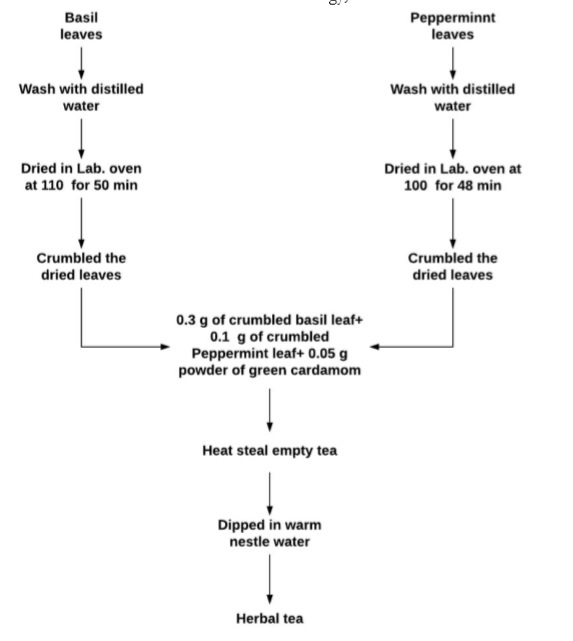
Figure 10. Flow of methodology in preparation of Herbal Tea.
Five different samples A, B, C, D and E of designed functional food product were served to the penal of 5 Judges. The amount of basil and peppermint is listed in Table 1
Table 1: Five samples of varying amounts of Basil and Peppermint.
Judges were asked to taste the food product and give their remarks as a score out of 10 scale about Aroma, Color, Texture, Taste and its overall acceptability. On the basis of sensory analysis, a sample was selected and phytochemical analysis were performed by using standard methods to identify alkaloids, flavonoids, Polyphenolics and antioxidant activity.
Preliminary extraction
About 10 g powdered Basil leaf and 40mL petroleum ether was mixed using magnetic stirrer and left the mixture for 1 day in ambient air. After 24 hours the sample was filtered by using Whatman No. 1 filter paper.
Ethanolic extraction
The residue was macerated with 70% ethanol (1:4) then stirrer for 30 minutes using magnetic stirrer and left for 1 day in ambient air. After 24 hours the sample was filtered by using filter paper. The residue was remunerated 2 times. Ethanol was removed from the filtrate using rotatory evaporator at 600C until it became viscous.
Ethyl acetate fraction
About 5 g of viscous extract and warm distilled water was inserted into mortar. Stirred it thoroughly then transferred it into another funnel. Now, we added ethyl acetate to extract suspension in same ratio and shaken it to form 2 layers. The upper layer separated which is soluble ethyl acetate fraction and filtered over Whatman filter paper. Insoluble lower layer was fractionated 2 times with ethyl acetate. We collected the entire soluble ethyl acetate fraction and evaporated it by a rotator evaporator at 600C. After that evaporation continued on water bath until it became viscous.
Identification of flavonoids
One drop of Ethyl acetate fraction and 1 drop of Ethanolic extract was dropped on filter paper separately and let them to dry. Filter paper with dried droplets steamed using ammonia gas. Which showed dimly yellow to intense yellow to examine the concentration of Flavonoids.
Identification of alkaloids
About 1 mL of Ethanolic extract and same quantity of ethyl acetate was taken for Mayer’s reagent. Formation of white precipitate showed that sample contained Alkaloids.
Identification of polyphenolics
About 3 drops of FeCl3 were added into 1 mL of Ethanolic extract and 1 mL of ethyl acetate fraction. Appearance of Dark black color showed that sample contains Polyphenolics.
DPPH assay
Free radical scavenging method was used for antioxidant activity test. The compound used to perform the activity test was 2, 2-diphenyl-1-picrilhidrazil.
Solution preparation
Stock solutions of each Quercetin (0.2 mg/mL), Ethanolic extract (2 mg/mL) and Ethyl acetate fraction (1 mg/mL) was prepared. From this stock solution further dilutions (50%, 25% and 12.5%) were made. For 0.15 mM DPPH, dissolved 15 mL of 1 mM DPPH in ethanol up to 100ml.
Procedure. To Perform DPPH test, sample was prepared by mixing 1.0 mL of each dilution in 1.0 mL of DPPH solution. The mixture was shaken well to homogenize and left in darkness for 90 min. Absorbance was measured at 517 nm by using UV-visible spectrometer. Each test is suggested to perform five times. [33]
Results and Discussions.
Sensory evaluation
A panel of 5 Judges tasted 5 different samples of designed functional food and presented their remarks as a score on 10 points scale about aroma, color, texture, taste and its overall acceptability. A score above 6 was considered acceptable. Results of sensory analysis are shown in Table 2
Table 2: Results of sensory analysis
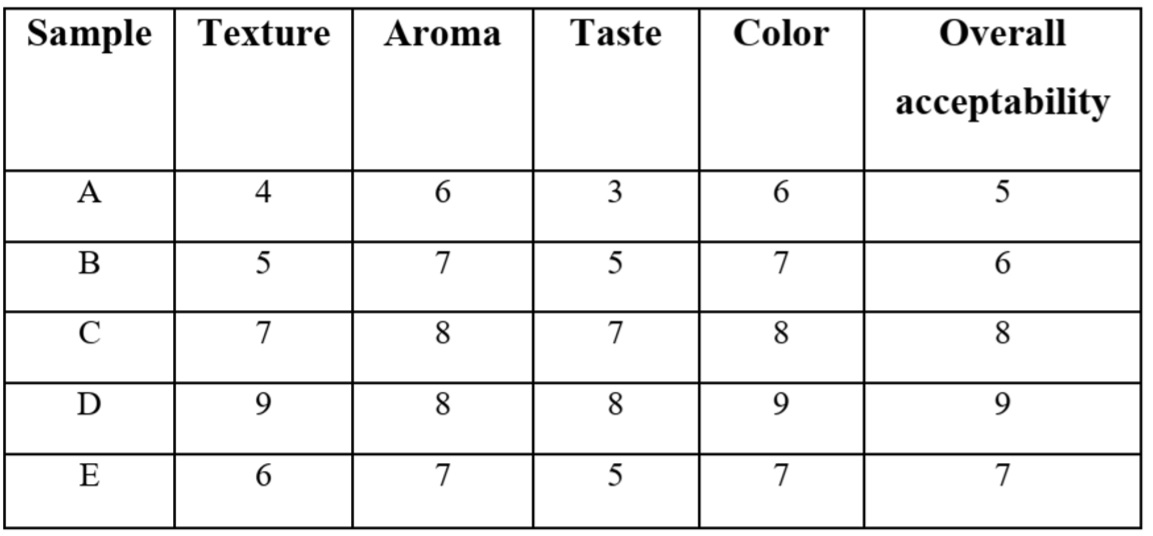
It was clear form sensory evaluation that sample C and sample D got maximum points. But sample D got highest points in aroma, texture, color, taste and overall acceptability. Therefore, sample D was selected for phytochemical analysis. Results are shown in Figure 11.
Extraction and fractionation
About 70% ethanol was used to extract the active basil compounds by maceration method. The use of the ethanol is advantageous because it has ability to extract flavonoid compound. In maceration method, we diffused the compounds to a low concentration.
Flavonoids identification
Conversion of dimly yellow color into intense yellow color was due to Flavonoids identification by Ethanolic extract and Ethyl acetate fraction. This color conversion indicated the presence of flavonoids. Yellow color occured due to the formation of quinoid that describes the reactions of ammonia with flavonoids. Quinoid contains a larger conjugated double bond. Results of Flavonoids identification are shown in Figure 12.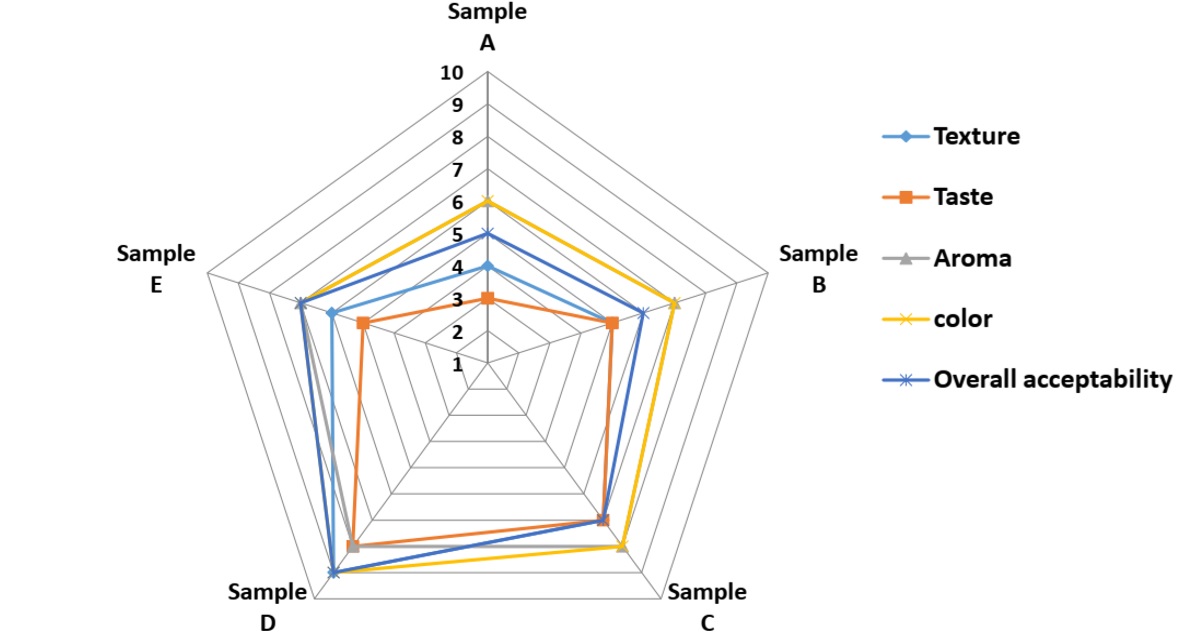
Figure 11. Sensory analysis of five samples.
Alkaloids identification
Formation of white precipitate with Mayer’s reagent of Ethanolic extract and Ethyl acetate fraction assisted to identify Alkaloid. Formation of precipitate indicated the presences of alkaloids. In Alkaloids there is a Nitrogen atom present with free electron pair. When Alkaloids react with dipotasium tetraiodomercurat (Mayer’s reagent), free electron pair of Nitrogen atom reacts with potassium metal ion through a coordinate covalent bond and potassium-alkaloid is characterized by white precipitate. Results of Alkaloid identification are shown in following Figure 14 and reactions of alkaloids with Mayer’s reagent are shown in Figure 15
Polyphenolics identification
When FeCl3 was added in Ethanolic extract and Ethyl acetate fraction, Green-brown color of Ethyl acetate fraction and Brown-black color of Ethanolic extract was changed into Black-brown color which showed that the sample have Polyphenolics compounds. When hydroxyl groups, present in Polyphenolics compounds, react with FeCl3 then Flavonoid-Fe+3 complexes were formed. Identification of polyphenolics is shown in Figure 16 and the reaction of Polyphenolics with FeCl3 is shown in Figure 17.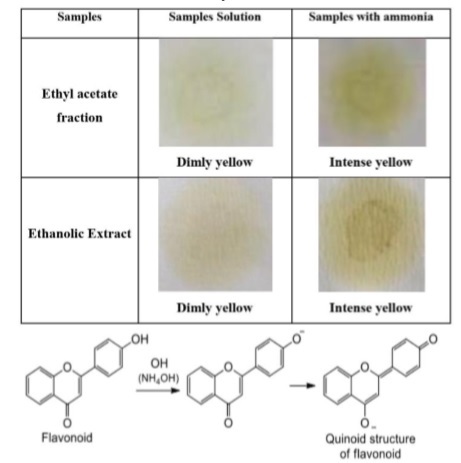
Figure 12. Identification of Flavonoids using ammonia.

Figure 14. Reaction of Alkaloid with Mayer’s reagent.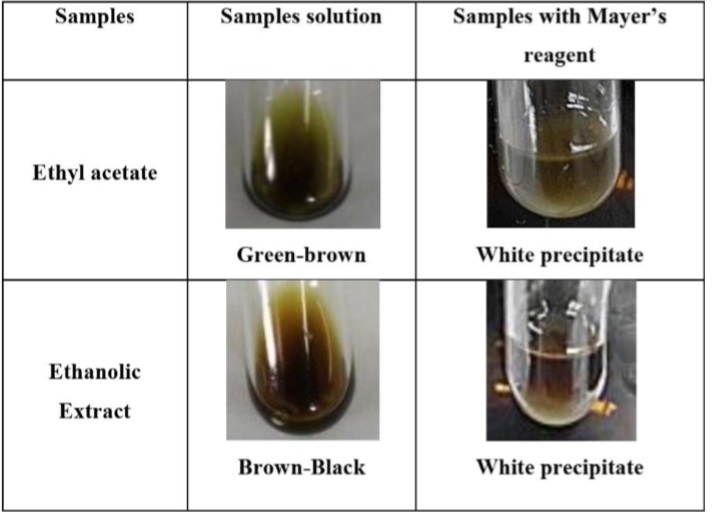
Figure 15. Identification of Alkaloids with Mayer’s reagent

Figure 16. Reactions of polyphenolics with FeCl3.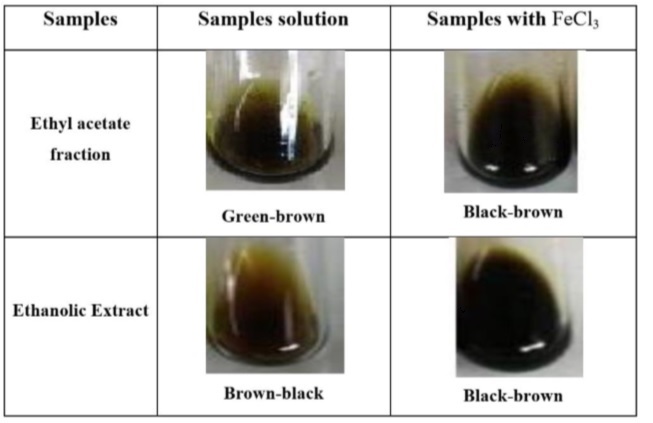
Figure 17. Identification of polyphenolics with FeCl3.
DPPH assay.
DPPH is very popular stable, natural and free radical used for anti-oxidant assay. It has free electrons, delocalized over entire molecule and responsible for its deep violet color in ethanolic extract and ethyl acetate fraction. Anti-oxidant effect of test sample is proportional to the disappearance of DPPH color from reaction mixture. Color of the test sample changes from dark violet to light yellow. Anti-oxidant effect of basil leaves extract in ethanol and ethyl acetate fraction was measured by making their dilutions (3mg/mL, 2mg/mL, 1.75mg/mL, 1.5mg/mL and 1mg/mL). DPPH shows maximum absorption peak at 517 nm indicating its deep color. Color of the solution change from violet to light yellow in the presence of DPPH as shown in Figure 18.
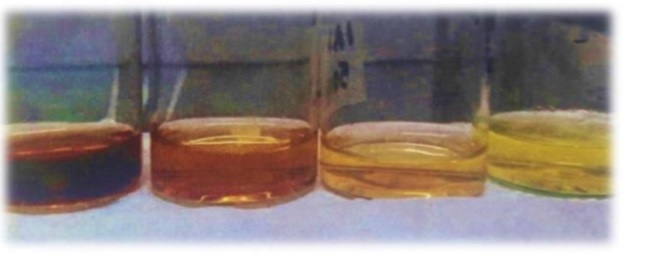
Figure 18. DPPH assay, percentage scavenging increased by increasing amount of Basil leaves.
Anti-oxidant potential increases by increasing the concentration of Basil leaves into solution. The results of antioxidant activity showed that potential activity of ethyl acetate fraction was higher than ethanolic extract of the basil leaf but less than Quercetin. Results are shown in Figure 19.

Figure 19. Antioxidant activity of Basil leaves in Ethanol, Ethyl acetate and Quercetin
Statistical analysis Percentage scavenging radical was measured by following formula:
IC50 is defined as an amount of sample required to decline in DPPH absorbance up to 50%. The values of Quercetin, Ethanolic extract and ethyl acetate were computed using SPSS which were computed as 95% confident. The antioxidant activity is shown in Table 3
Table 3. CV percentage of various samples.
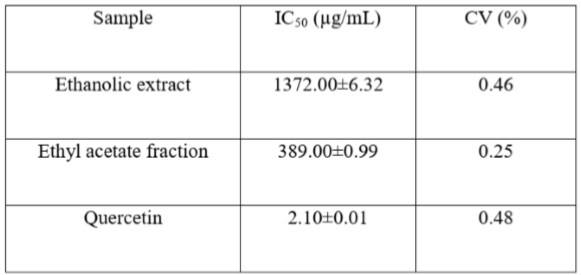
The results of antioxidant activity showed that potential antioxidant activity of ethyl acetate fraction was higher than ethanolic extract of the basil leaf, but less than Quercetin. Finally, a potential food is shown in the Figure 20.

Figure 20. Prepared Food product.
Conclusion A potential functional food was successfully prepared to control hypertension. Sensory evaluation showed that herbal tea tastes good and met the level of hedonic demand. Phytochemical analysis showed the availability of flavonoids, alkaloids and Polyphenolics. Antioxidant potential of basil leaf was measured through DPPH assay. It was confirmed that basil is a good source of antioxidant activity. On the basis of these characterizations it was confirmed that basil leaf can be used to control hypertension.
Recommendations. This food product can be easily prepared on commercial scale. Composition can be varied according to the consumer demands and as per condition of blood pressure patient. Herbal tea could be prepared with the sweet taste by using specified amount of honey. Sugar patients may use this herbal tea without addition of honey. Cardamom can also be replaced with Lemon, Cinnamon, Cloves and honey as food additive. Shelf life of herbal tea could be enhanced by using preservatives. Use of this herbal tea twice in a day can significantly control hypertension.
Acknowledgement. We acknowledge this work to Chemistry department, University of the Punjab Lahore.
Author’s Contribution. All the authors contributed equally.
Conflict of interest. Authors declare no conflict of interest for publishing this manuscript in IJIST.
1.0 Project details. NIL
References
[1] W. H. Organization., "Información General Sobre la Hipertensión en el Mundo–OMS.," http://apps.who.int/iris/bitstream/10665/87679/1/WHO_DCO_WHD_2013.2_spa.pdf, 2013.
[2] W. H. Organization, "Global Health Risks Global Health Risks. Mortality and Burden of Disease Attributable to Selected Major Risks," http://www.who.int/healthinfo/global_burden_disease/GlobalHealthRisks_report_full.pdf
[3] D. McCartney, D. Byrne and M. Turner, "Dietary contributors to hypertension in adults reviewed," Ir. J. Med. Sci, vol. 184, p. 81–90, 2015. (crossref)
[4] R. Eckel, J. Jakicic, J. Ard, J. De Jesus, N. Houston Miller, V. Hubbard, I. Lee, A. Lichtenstein, C. Loria, B. Millen and e. al, "2013 AHA/ACC guideline on lifestyle management to reduce cardiovascular risk: A report of the American college of cardiology/American heart association task force on practice guidelines.," J. Am. Coll. Cardiol, vol. 63, pp. 2960-2984, 2014. (crossref)
[5] L. Schwingshackl and G. Hoffmann, "Mediterranean dietary pattern, inflammation and endothelial function: A systematic review and meta-analysis of intervention trials," Nutr. Metab. Cardiovasc. Dis, vol. 24, p. 929–939, 2014. (crossref)
[6] R. Estruch, E. Ros, J. Salas-Salvado, M. Covas, D. Corella, F. Aros, E. Gomez-Gracia, V. Ruiz-Gutierrez, M. Fiol, J. Lapetra and e. al., "Primary prevention of cardiovascualr disease with a Mediterranean diet.," N. Engl. J. Med., vol. 386, p. 1279–1290, 2013. (crossref)
[7] A. D’Alessandro and G. De Pergola, " The Mediterranean Diet: Its definition and evaluation of a priori dietary indexes in primary cardiovascular prevention.," Int. J. Food Sci. Nutr., vol. 69, p. 647–659., 2018. (crossref)
[8] W. Willett, F. Sacks, A. Trichopoulou, G. Drescher, A. Ferro-Luzzi, E. Helsing and D. Trichopoulos, "Mediterranean diet pyramid: A cultural model for healthy eating.," Am. J. Clin. Nutr., vol. 61, p. 1402S–1406S, 1995. (crossref)
[9] C. Davis, J. Bryan, J. Hodgson and K. Murphy, "Definition of the Mediterranean diet: A literature review.," Nutrients, vol. 7, p. 9139–9153, 2015. (crossref)
[10] A. D’Alessandro and G. De Pergola, "Mediterranean diet pyramid: A proposal for Italian people.," Nutrients , vol. 6, p. 4302–4316., 2014. (crossref)
[11] C. R. R. P. F. G. F. a. V. S. D. Stanton, ""Fermented functional foods based on probiotics and their biogenic metabolites.”," Current Opinion in Biotechnology,, vol. 16, p. 198–203, 2005. (crossref)
[12] S. C. Lee and M. H. Foo, "Functional Foods and Its Biomarkers.," in Introduction to Functional Food Science, 2nd ed. ed., Richardson, TX: Functional Food Center, 2014.
[13] M. M. Danik and S. Jaishree, "A new Definitation for Functional food by FFC: what makes a new definition unique?," FFC, vol. 6, no. 5, pp. 209-223,, 2015.
[14] S. Lewington, R. Clarke, N. Qizilbash, R. Peto and R. Collins, "Age specific relevance of usual blood pressure to vascular mortality: a meta-analysis of individual data for one million adults in 61 prospective studies.," Lancet, vol. 360, p. 1903–1913, 2002. (crossref)
[15] T. E. Shelly, D. O. Melnnis, E. Pahio and J. Edu, "Aromatherapy in the Mediterranean fruit fly (Diptera Tephritidae): Sterile males exposed to ginger root oil in pre-release storage boxes display increased mating competitiveness in freed-cage trials.," Journal of Economic Entomology, vol. 97, no. 3, pp. 846-853, 2004. (crossref)
[16] M. Taati, M. Alirezaei, M. Meshkatalsadat, B. Rasoulian, A. Kheradmand and S. Neamati, "“Antioxidant effects of aqueous fruit extract of Ziziphus jujuba on ethanolinduced oxidative stress in the rat testes.”," Iranian J Vet Res, vol. 39, no. 1, p. 4, 2011.
[17] Wilson and Ross, “Anatomy and Physiology in Health and Illness”, 10th ed ed., Churchill Livingstone, 2006, pp. 80-92.
[18] K. D. Tripathi, “Essentials of medical pharmacology”, 6th ed., Jaypee Brothers Medical, 2013, pp. 135,.
[19] R. Satoskar, “Pharmacology and Pharmacotherapeutics”, 20th ed., Popular Pakistan Pvt Limited, 2011, pp. 402-431.
[20] R. a. P. T. P. Dr. Gaud, “Modern Patient Counseling”, Nirali Prakashan, 2008.
[21] K. C. Sujit, “Concise Medical Physiology”, 6th ed ed., India, New central Book Agency, 2008, pp. 177-180.
[22] K. B. Devin, "“Idiopathic Intracranial Hypertension”," Nurosurgery, vol. 54, no. 3, pp. 538-552, 2004.
International Journal of Innovations in Science & Technology
February 2019 | Vol 1|Issue 1 Page | 32
[23] T. Martin, "“Hypertension clinical features and investigation”," Hospital Pharmacist,, vol. 14, 2007.
[24] P. Prakash and N. Gupta, "“Therapeutic uses of Ocimum sanctum Linn (Tulsi) with a note on eugenol and its pharmacological actions: a short review”," Indian J. Physiol. Pharmacol,, vol. 49, pp. 125-131, 2005.
[25] G. P. Kamatou, I. Vermaak and A. M. Viljoen, "“Eugenol from the remote Maluku Islands to the international market place: a review of a remarkable and versatile molecule.”," Molecules, vol. 17, pp. 6953- 6981, 2012. (crossref)
[26] M. K. Yadav, S. W. Chae, G. J. Im, J. W. Chung and J. J. Song, "“Eugenol: a phyto-compound effective against methicillin-resistant and methicillin-sensitive Staphylococcus aureus clinical strain biofilms.," PLoS One, vol. 10, no. 3, 2015. (crossref)
[27] W. Van and E. Ben, "“Food Plants of the World.”," Timber Press, Inc, p. 256, 2005.
[28] L. C. Chiang, "“Antiviral activities of extracts and selected pure constituents of Ocimum basilicum.”," Clin Exp Pharmacol Physiol, vol. 32, no. 10, pp. 811-6, 2005. (crossref)
[29] S. Min, A. Fatah, M. Mchael, A. J. M. and Q. S. Xiao, "“ Effects of fermentation conditions on the potential anti-hypertensive peptides released from yogurt fermented by Lactobacillus helveticus and Flavourzyme”," vol. 52, pp. 137-145, 2016. (crossref)
[30] N. C. Cook and S. Samman, "“Flavonoids-chemistry, metabolism, cardioprotective effects and dietary source.”," Nutri. Biochem., vol. 7, pp. 66-76, 1996.
[31] J. T. Kumpulainen and J. T. Salonen, "“Natural antioxidants and anticarcinogens in nutrition, health and disease.”," Royl. Soci. Chem. UK., vol. 240, pp. 178-187, 1999. (crossref)
[32] Pavia, Lampman, Lriz and Vyvyan., “Introduction to Spectroscopy”, 5th ed., Cengage Learing,, 2015, pp. 577-583,.
[33] A. R. Warsi, “Phytochemical screening and antioxidant activity of ethanolic extract and ethyl acetate fraction from basil leaf (Ocimum basilicum L.) By DPPH radical scavenging method.”," Material Science and Engineering,, p. 259, 2017. (crossref)
[34] J. O. T. Voogt, " Thermal remote sensing of urban climates.," Remote Sens. Environ., vol. 86, p. 370–384., 2003. (crossref)




















